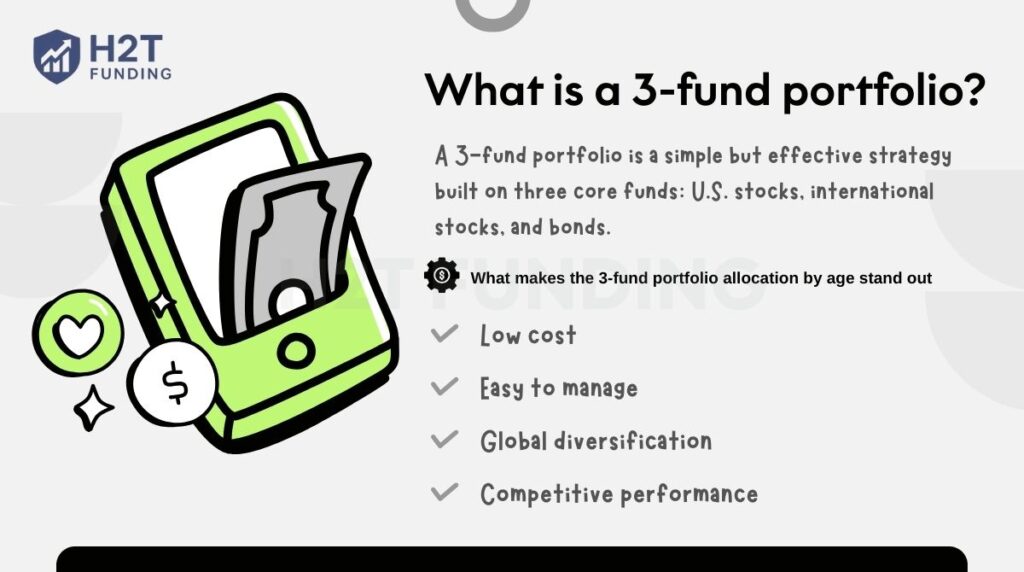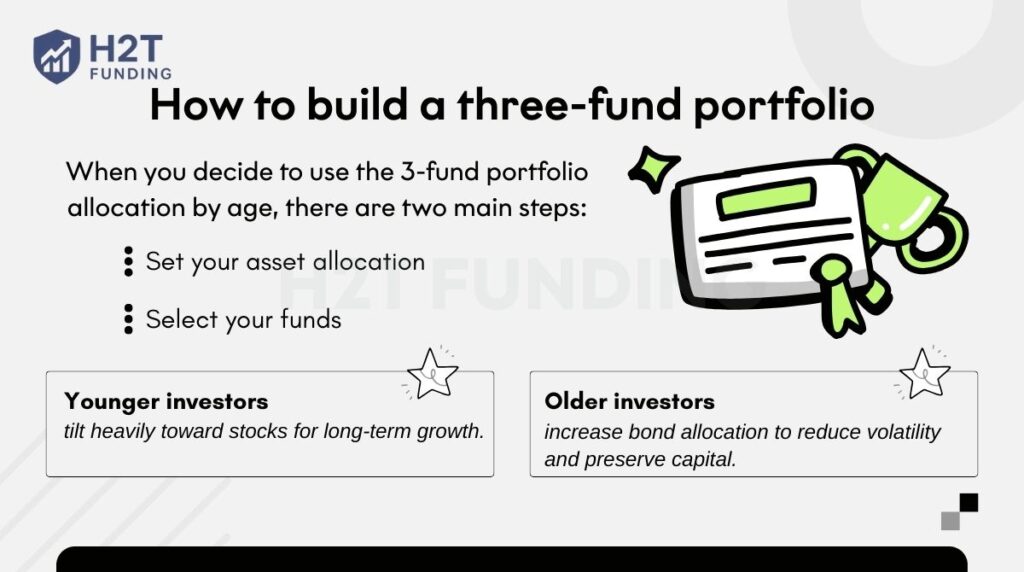Like many investors, I once found myself asking “what should my portfolio allocation be?”. The choices felt endless: index funds, ETFs, complex strategies that seemed built for Wall Street rather than real life.
But with the 3 fund portfolio by age, the path became clear: a proven framework that balances growth and protection without the noise of overcomplicated strategies.
The 3 fund portfolio allocation by age focuses on just three core funds: U.S. stocks, international stocks, and bonds. By adjusting their mix as you get older, leaning on stocks when you’re young and shifting toward bonds as retirement nears, you create a strategy that is both practical and sustainable.
In this guide, you’ll discover:
- What is the 3 fund portfolio and why it’s trusted by so many investors.
- How to adjust allocations by age to stay on track for long-term success.
- Practical examples and comparisons with target-date funds, so you can see what truly fits your needs.
If you’re looking for a low-cost, time-tested way to invest that grows alongside your life, this breakdown will give you the confidence to start and stick with it. Let’s dive in and build a portfolio designed for your future.
Key takeaways
- The 3 fund portfolio is a simple strategy built on U.S. stocks, international stocks, and bonds, adjusted by age for balance.
- Younger investors may hold 80–90% stocks, while those near retirement often shift to 60–70% bonds.
- Investors can use the formula 100–age to set stock percentages, with bonds making up the rest.
- The 3 fund portfolio allocation by age can help you achieve low-cost diversification and steady growth, though it lacks exposure to alternatives like real estate or commodities.
1. What is a 3-fund portfolio?
A 3-fund portfolio is a simple but effective strategy built on three core funds: U.S. stocks, international stocks, and bonds. It’s usually created with low-cost index funds or ETFs, giving investors broad market exposure without the complexity of picking individual securities or relying on a broker in trading.

The main appeal of a 3-fund portfolio lies in its balance of simplicity and long-term efficiency. Instead of managing a complex mix of assets, investors can achieve global diversification with only three building blocks.
This approach reduces risk because weakness in one market can be offset by strength in another. What makes the 3-fund portfolio allocation by age stand out is its simplicity and clarity, especially when paired with a solid grasp of financial terms for every beginner.
- Low costs: Index funds generally have lower expense ratios compared to actively managed funds, allowing investors to keep more of their returns.
- Easy to manage: With only three funds to track and rebalance, it saves time and effort.
- Global diversification: Covering U.S. markets, international markets, and bonds creates stability and reduces volatility.
- Competitive performance: Despite its simplicity, the 3-fund portfolio often matches or even outperforms more complicated portfolios due to cost efficiency and broad market exposure.
By combining simplicity, transparency, and sustainable returns, the 3-fund portfolio has become a go-to strategy for many individual investors, especially those who embrace the philosophy of “keeping investing simple” for long-term growth.
Quick insight: International stocks provide growth potential, particularly in emerging markets, while also diversifying beyond U.S. equities. Bonds may lack high returns but deliver stability and lower risk. As retirement approaches, investors often increase bond allocations to safeguard income.
2. Why allocation by age matters
The way you invest at 25 should not look the same as when you’re 55. Your time horizon and risk tolerance naturally change with age, and your portfolio needs to reflect that. This is where the three-fund portfolio allocation by age shines; it adapts to your financial goals as your life stage evolves.
2.1. Risk and investing horizon
In your 20s and 30s, time is your biggest asset. You can afford to take on more risk because market downturns, while painful, are temporary setbacks in a decades-long journey. A young investor can ride out a 30% decline knowing there’s plenty of time for recovery.
As retirement approaches, priorities shift. Instead of maximizing returns, the focus turns to capital preservation and stable income. A 60-year-old planning to retire within five years doesn’t have the same margin for error, so a higher allocation to bonds protects against sudden market shocks.
See more helpful articles:
2.2. The “Age in Bonds” principle
A widely used guideline is the “Age in Bonds” rule. Under this guideline, your bond allocation roughly matches your age. For instance, at 30 years old, you might hold 30% bonds and 70% stocks. The idea is to gradually add stability as you age.
Of course, this isn’t one-size-fits-all. Some investors prefer a slightly more aggressive twist, using Age–10 or even Age–20 as their bond percentage.
From my experience, those with steady income or a strong risk appetite often choose these adjusted versions, while conservative investors stick to the classic formula. The key is finding the balance that lets you sleep well at night while staying on track for your goals.
3. How to build a three-fund portfolio
When you decide to use the 3-fund portfolio allocation by age, there are two main steps:

- Set your asset allocation: decide the percentage mix of U.S. stocks, international stocks, and bonds. Just like when you create a personal budget, the goal is to find a balance that fits your situation and long-term plan.
- Select your funds: choose low-cost, well-diversified index funds or ETFs that represent each asset class.
Many beginners start by asking, “What should my portfolio allocation be?”. The answer depends on your age and time horizon.
- Younger investors -> tilt heavily toward stocks for long-term growth.
- Older investors -> increase bond allocation to reduce volatility and preserve capital.
This isn’t just theory; I went through this exact process with my younger brother when he turned 25. He was ready to invest but admitted he was nervous about diving in headfirst.
So, we landed on an 80/20 stock-to-bond split. It was aggressive enough for his 40-year timeline but had that 20% bond cushion to help him sleep at night, which was crucial for keeping him invested.
A common rule of thumb is:
100 – age = % in stocks
- Age 30 -> 70% stocks, 30% bonds
- Age 50 -> 50% stocks, 50% bonds
Once you know your mix, it’s time to pick the actual funds. Most major brokers offer the right options, and expense ratios are usually under 0.10%. A simple lineup could look like this:
- U.S. stocks: Vanguard Total Stock Market ETF (VTI) or VTSAX (mutual fund)
- International stocks: Vanguard Total International Stock ETF (VXUS) or VTIAX
- Bonds: Vanguard Total Bond Market ETF (BND) or VBTLX
The beauty of this approach is that whether you’re 25 or 65, the framework stays the same. What changes is the ratio of stocks to bonds, based on your goals and risk tolerance. By using broad, low-cost funds, you keep your portfolio simple, diverse, and built for the long term.
4. Pros and cons of a 3 fund portfolio allocation by age
Every investment strategy has trade-offs, and the 3-fund portfolio allocation by age is no exception. Its greatest strength is simplicity; three funds cover nearly the entire global stock and bond market. But the benefits and drawbacks can look very different depending on whether you’re just starting, mid-career, or nearing retirement.
| Age Group | Pros | Cons |
|---|---|---|
| 20s–30s | Simple entry point; broad diversification; very low costs. High stock exposure can accelerate long-term growth. | Requires discipline during downturns; may feel “too plain” compared to chasing hot sectors. |
| 40s–50s | Balanced mix of growth and stability; flexibility to adjust allocations manually rather than relying on preset target-date funds. | Needs periodic rebalancing; risk of underperforming specialized funds during strong bull markets. |
| 60s+ | Focus on capital preservation with higher bond allocation; clear, low-maintenance structure. | Lower returns vs. more aggressive strategies; limited exposure to alternative assets like REITs or commodities. |
In short, the three-fund portfolio allocation by age works because it evolves with you. Younger investors benefit from growth-focused simplicity, while older investors enjoy a defensive structure that shields savings.
The trade-off is giving up “fancy” strategies or alternatives, but what you gain is a system that is low-cost, flexible, and sustainable across every stage of life.
5. Sample 3-fund portfolio allocations by age
A 3-fund portfolio allocation by age is designed to grow with you. When you’re young, the focus is on stocks for long-term growth. As the years pass, bonds take up a larger share to reduce risk and provide stability. Below is a 3-fund portfolio example:
| Age | U.S. Stocks | International Stocks | Bonds |
|---|---|---|---|
| 25 | 50% | 30% | 20% |
| 35 | 45% | 25% | 30% |
| 45 | 40% | 20% | 40% |
| 55 | 35% | 15% | 50% |
| 65 | 30% | 10% | 60% |
| 75 | 25% | 5% | 70% |
I remember this vividly in 2021. My portfolio was flying high on a stock market rally and had drifted to over 80% stocks. Every part of me wanted to let it ride, but my plan said 70%. It was tough to sell the winners to buy ‘boring’ bonds, but that single act of discipline locked in gains and reset my risk.
The logic is simple: as you age, bonds increase to protect capital, while stocks are trimmed back to lower volatility. International exposure remains part of the mix to keep global diversification.
Continue reading: How to create an optimal budget to buy a house by 30
6. How to rebalance your 3-fund portfolio as you age
Even with a clear three-fund portfolio allocation by age, your portfolio won’t stay perfectly aligned forever. Market swings can shift allocations, so rebalancing is key to keeping your mix in line with your goals, just like following a disciplined trading plan.
6.1. When should you rebalance?
A common approach is to rebalance once a year or every six months. Another method is “threshold rebalancing”, whenever an asset drifts more than 5–10% from its target, it’s time to adjust.
For example, in 2021, my target was 70% stocks and 30% bonds, but after a strong bull run, stocks grew to nearly 82% of my portfolio. I rebalanced by shifting part of the gains into bonds, which locked in profits and brought my risk back under control.
6.2. How to rebalance effectively
The simplest way is to use new contributions. By directing fresh money into the underweighted fund, you bring your portfolio back to balance without triggering taxes. This has been my go-to method in retirement accounts, and it feels effortless.
If you need a quicker fix, you can sell from overweighted funds and buy the underweighted ones. In taxable accounts, though, this can trigger capital gains, so it’s important to manage carefully, much like when you track your net worth to see the real impact of your financial moves.
Rebalancing is less about chasing returns and more about staying disciplined. Whether you do it annually or when allocations drift, the goal is to keep your three-fund portfolio allocation by age aligned with your long-term plan, ensuring your risk and rewards remain in balance as you grow older.
7. Comparison 3-fund portfolio vs target date fund
Both the 3-fund portfolio allocation by age and target-date funds are designed to simplify investing, but they differ in how much control you want over your money. Understanding the trade-offs helps you choose the approach that best fits your style and discipline.
| Criteria | 3-Fund Portfolio | Target-Date Fund |
|---|---|---|
| Age-based adjustment | In the manual, the investor must rebalance | Automatic, adjusts with time |
| Control & flexibility | High, can tweak allocations anytime | Low, follows preset glide path |
| Management fees | Very low (0.03–0.08%) | Moderate (0.15–0.35%) |
| Transparency of holdings | Clear, you see exactly what’s inside | Limited, less direct oversight |
It really comes down to personality. I’m the type of person who likes to tinker and feel in control. But my colleague, a busy father of two, puts everything into a target-date fund. His philosophy is simple: “My time is better spent with my kids than worrying about rebalancing percentages.” And for him, that’s absolutely the right call.
The bottom line: target-date funds are perfect for set-it-and-forget-it investors, while the 3-fund portfolio is best for those who want maximum control at minimum cost. Both approaches can work; the key is choosing what fits your style, just as you might pick from the best personal finance podcasts that match your learning preferences.
8. FAQs
There’s no single “best” allocation, but a common rule is 100–age = % in stocks. Younger investors hold more stocks for growth, while older investors shift to bonds for stability. Adjustments like 110 – age or 120 – age are used by those comfortable with more risk.
The classic setup uses three low-cost index funds: a U.S. total stock market fund, an international stock fund, and a total bond market fund. Vanguard’s VTI, VXUS, and BND are often cited as the standard example.
Yes, it’s one of the most popular retirement strategies. By gradually increasing bonds as you age, the three-fund portfolio allocation by age balances growth and safety, making it suitable for both wealth-building and income protection.
The main advantages are simplicity, diversification, and low cost. With just three funds, you gain exposure to thousands of securities worldwide at expense ratios as low as 0.03%, keeping more of your returns over time.
At 70, most investors prioritize capital preservation. A common mix is around 30–40% stocks and 60–70% bonds, with a small portion in international equities for diversification.
At 60, many investors still want moderate growth but with reduced risk. A balanced allocation might be 40–50% stocks and 50–60% bonds, depending on income needs and retirement timing.
The answer depends on your age, risk tolerance, and goals. Use a guideline like 100–age as a starting point, then adjust for your comfort. Younger investors often keep 80–90% in stocks, while retirees tilt heavily toward bonds for security.
9. Conclusion
The 3 fund portfolio allocation by age is one of the simplest and most effective strategies for building wealth. With just three funds, you can achieve global diversification, low costs, and an allocation that adapts naturally as you move through different life stages.
There’s no single “perfect mix” for everyone. Your ideal allocation depends on your risk tolerance, financial goals, and time horizon. Think of the model as a flexible guide. Start with the basic ratios, then adjust to what helps you stay consistent and confident.
If you’re ready to take control of your future, begin with a simple 3-fund portfolio, track your progress, and rebalance as you age. For more step-by-step approaches to managing money wisely, explore the Budgeting Strategies section at H2T Funding and start shaping a plan that fits your life.





